1993 BUICK CENTURY weight
[x] Cancel search: weightPage 145 of 324
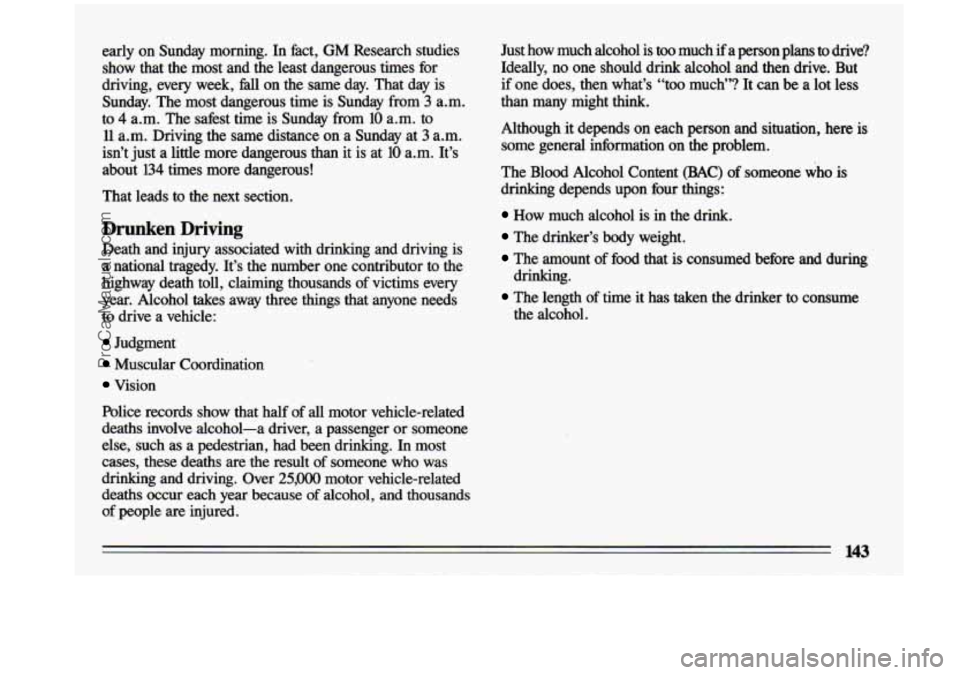
early on Sunday morning. In fact, GM Research studies
show that the most and the least dangerous times for
driving, every week, Ml on the same day. That day is
Sunday. The most dangerous time is Sunday from
3 a.m.
to
4 a.m. The safest time is Sunday from 10 a.m. to
11 a.m. Driving the same distance on a Sunday at 3 a.m.
isn’t just a
little more dangerous than it is at 10 a.m. It’s
about
134 times more dangerous!
That leads to the next section.
Drunken Driving
Death and injury associated with drinking and driving is
a national tragedy. It’s the number one contributor to the
highway death toll, claiming thousands of victims every
year. Alcohol takes away three things that anyone needs
to drive a vehicle: Just how much alcohol
is too much if a person plans to drive?
Ideally, no one should drink alcohol and then drive. But
if one does, then what’s “too much”? It can be a lot
less
than many might think.
Although it depends on each person and situation, here is
some general information on the problem.
The Blood Alcohol Content
(BAC) of someone who is
drinking depends upon four things:
How much alcohol is in the drink.
The drinker’s body weight.
The amount of food that is consumed before and during
The length of time it has taken the drinker to consume
drinking.
the alcohol.
Judgment
Muscular Coordination
Vision
Police records show that half of all motor vehicle-related
deaths involve alcohol-a driver, a passenger or someone
else, such as a pedestrian, had
been drinking. In most
cases, these deaths are the result
of someone who was
drinking and driving. Over
25,000 motor vehicle-related
deaths occur each year because
of alcohol, and thousands
of people are injured.
ProCarManuals.com
Page 146 of 324
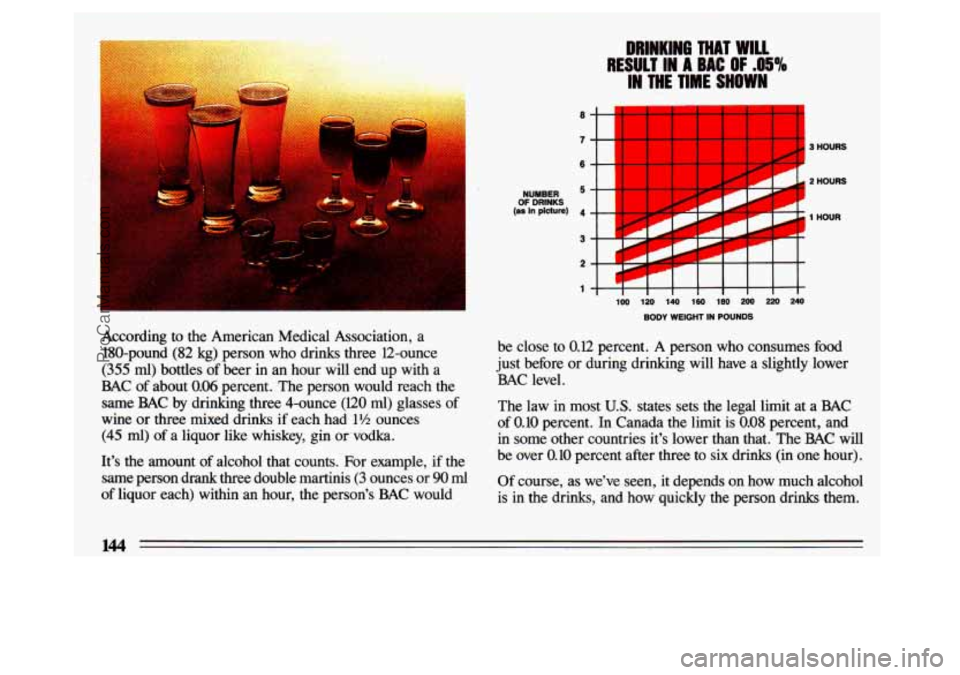
According to the American Medical Association, a
18O-pound’(82 kg) person who drinks three 12-ounce
(355 ml) bottles of beer in an hour will end up with a
BAC of about 0.06 percent. The person would reach the
same BAC
by drinking three 4-ounce (120 ml) glasses of
wine or three mixed drinks if each had
1% ounces
(45
ml) of a liquor like whiskey, gin or.vodka.
It’s the amount of alcohol that counts. For example,
if the
same person
drank three double martinis (3 ounces or 90 ml
of liquor each) within an hour, the person’s BAC would
DRINKING THAT WILL
RESULT IN A BAC OF .05%
IN THE TIME SHOWN
OF DRINKS
NUMBER (as in picture) 4
I HOURS
IFglT 1 &
100 120 140 160 1ao 200 220 240
BODY WEIGHT IN POUNDS
be close to 0.12 percent. A person who consumes food
just
before or during drinking will have a slightly lower
BAC level.
The law in most
U.S. states sets the legal limit at a BAC
of 0.10 percent. In Canada the limit
is 0.08 percent., and
in some other countries it’s lower than that. The BAC will
be over
0.10 percent after three to six drinks (in one hour).
Of course, as we’ve seen, it depends on how much alcohol
is in the drinks, and how quickly the person drinks them.
144
ProCarManuals.com
Page 172 of 324
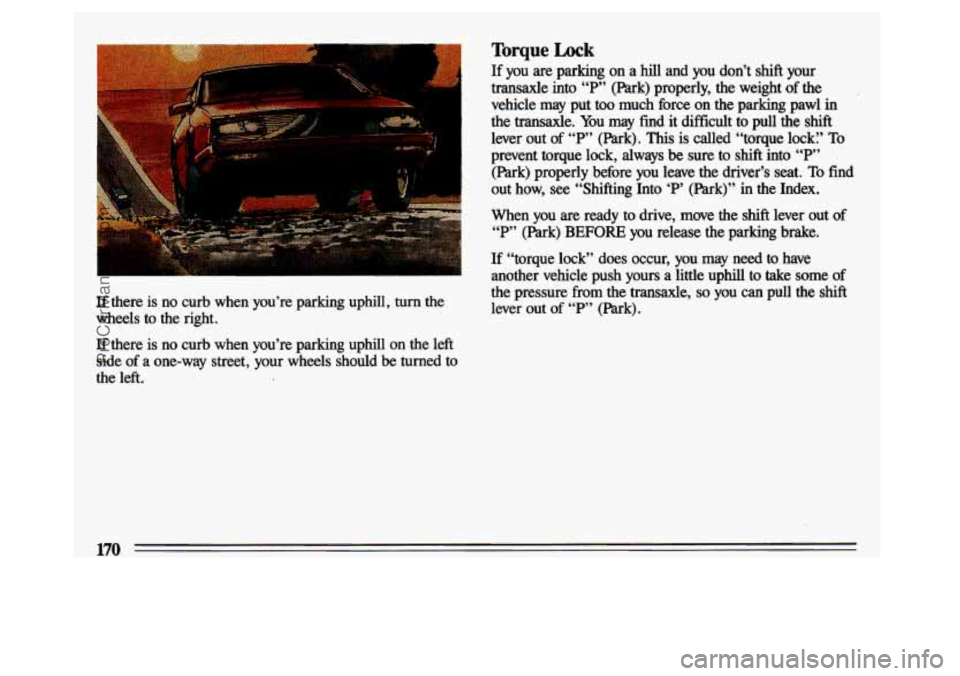
If there is no curb when you’re parking uphill, turn the
wheels to the right.
If there is no curb when you’re parking uphill on the left
side of
a one-way street, your wheels should be turned to
the left.
Torque Lock
If you are parking on a hill and you don’t shift your
transaxle into
“P” mk) properly, the weight of the
vehicle may put
too much force on the parking pawl in
the transaxle. You may find it difficult to pull the shift
lever out of “I”’ (Park). This is called “torque lock:’ To
prevent torque lock, always be sure to shift into “P”
(Park) properly before you leave the driver’s seat. To find
out how, see “Shifting Into ‘P’ (Park)” in the Index.
When you are ready
to drive, move the shift lever out of
“P” (Park) BEFORE you release the parking brake.
If “torque lock” does occur, you may need to have
another vehicle push yours a little uphill to take some of
the pressure from the transaxle,
so you can pull the shift
lever out of “P” (Park).
170
ProCarManuals.com
Page 177 of 324
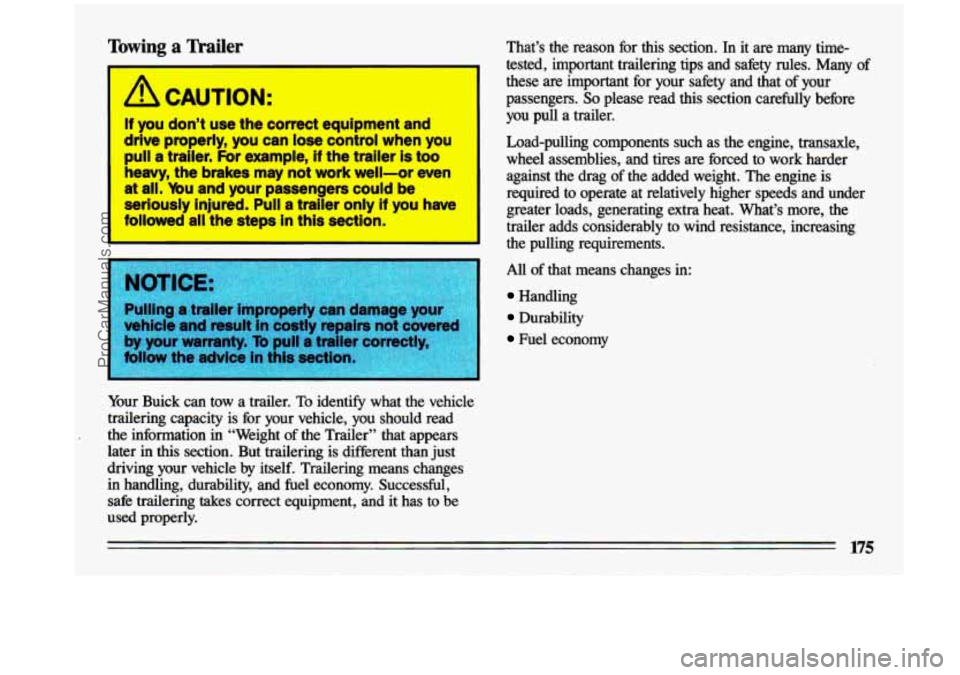
Towing a Trailer
A CAUTION:
If you don’t use the correct equipment and
drive properly, you can lose control when you
pull a traller. For example, If the trailer is too
heavy, the brakes may not work well--or wen
at all. Mu and your passengets could be
seriously Injured. Pull a trailer only if you have
followed all the steps in this section.
hicle and result
Your Buick can tow a trailer. To identify what the vehicle
trailering capacity is for your vehicle, you should read
the information in “Weight of the Trailer” that appears
later
in this section. But trailering is different than just
driving your vehicle
by itself. Trailering means changes
in handling, durability, and fuel economy. Successful,
safe trailering
takes correct equipment, and it has to be
used properly. That’s the reason for this section.
In it are many time-
tested, important trailering tips and safety rules. Many
of
these are important for your safety and that of your
passengers.
So please read this section carefully before
you pull a trailer.
Load-pulling components such as the engine, transaxle,
wheel assemblies, and tires are forced to work harder against the drag of the added weight. The engine is
required to operate at relatively higher speeds and under
greater loads, generating extra heat. What’s more, the
trailer adds considerably
to wind resistance, increasing
the pulling requirements.
All of that means changes in:
Handling
Durability
Fuel economy
175
ProCarManuals.com
Page 178 of 324
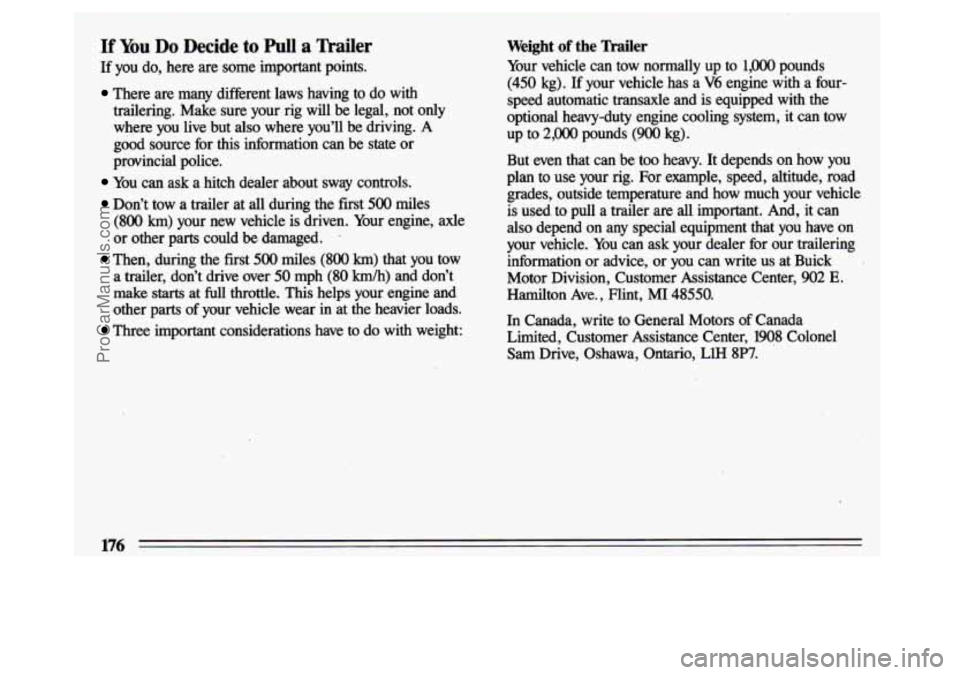
If You Do Decide to Pull a Trailer
If you do, here are some important points.
There are many different laws having to do with
trailering. Make sure your rig will be legal, not only where you live but also where you’ll be driving.
A
good source for this information can be state or
provincial police.
You can ask a hitch dealer about sway controls.
Don’t tow a trailer at all during the first 500 miles
(800 km) your new vehicle is driven. Your engine, axle
or other parts could be damaged. .
Then, during the first 500 miles (800 km) that you tow
a trailer, don’t drive over 50 mph (80 Wh) and don’t
make starts at full throttle. This helps your engine and
other parts of your vehicle wear
in at the heavier loads.
Three important considerations have to do with weight:
Weight of the Trailer
Your vehicle can tow normally up to 1,OOO pounds
(450 kg). If your vehicle has a V6 engine with a four-
speed automatic transaxle and is equipped with the
optional heavy-duty engine cooling system,
it can tow
up to 2,000 pounds
(900 kg).
But even that can be too heavy. It depends on how you
plan to use your rig. For example, speed, altitude, road grades, outside temperature and how much your vehicle
is used to pull
a trailer are all important. And, it can
also depend on any special equipment that you have on
your vehicle. You can ask your dealer for our trailering
information or advice, or you can write us at Buick
.
Motor Division, Customer Assistance Center, 902 E.
Hamilton Ave., Flint, MI 48550.
In Canada, write to General Motors of Canada
Limited, Customer Assistance Center, 1908 Colonel
Sam Drive, Oshawa, Ontario,
LlH 8W.
176
ProCarManuals.com
Page 179 of 324
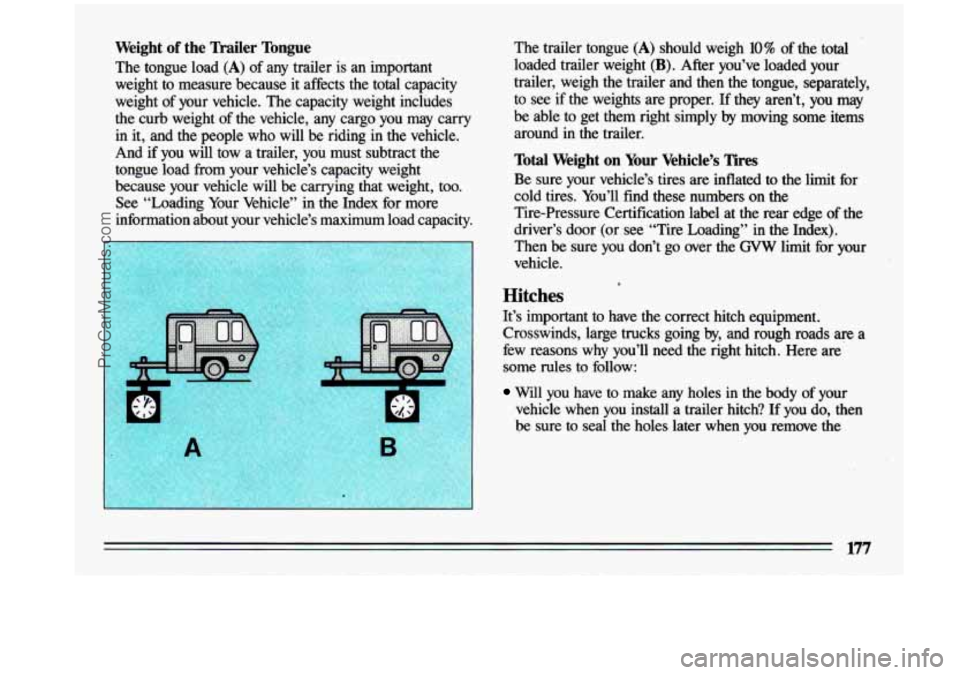
Weight of the Trailer Tongue
The tongue load (A) of any trailer is an important
weight to measure because it affects the total capacity
weight of your vehicle. The capacity weight includes
the curb weight
of the vehicle, any cargo you may carry
in it, and the people who will be riding in the vehicle.
And if you will tow a trailer, you must subtract the
tongue load from your vehicle’s capacity weight
because your vehicle will be carrying that weight, too. See “Loading Your Vehicle” in the Index for more
information about your vehicle’s maximum load capacity. The trailer tongue
(A) should weigh 10% of
the total
loaded trailer weight
(B). After you’ve loaded your
trailer, weigh the trailer and then the tongue, separately,
to see if the weights are proper.
If they aren’t, you may
be able to get them right simply by moving some items
around in the trailer.
Total Weight on Your Vehicle’s Tires
Be sure your vehicle’s tires are inflated to the limit for
cold tires. You’ll find these numbers on
the
Tire-Pressure Certification label at the rear edge of the
driver’s door (or see “Tire Loading” in the Index). Then be sure you don’t go over the
GVW limit for your
vehicle.
Hitches
It’s important to have the correct hitch equipment.
Crosswinds, large trucks going by,
and rough roads are a
few reasons why you’ll need the right hitch. Here are
some rules
to follow:
Will you have to make any holes in the body of your
vehicle when you install a trailer hitch?
If you do, then
be sure to seal the holes later when you remove the
177
ProCarManuals.com
Page 181 of 324
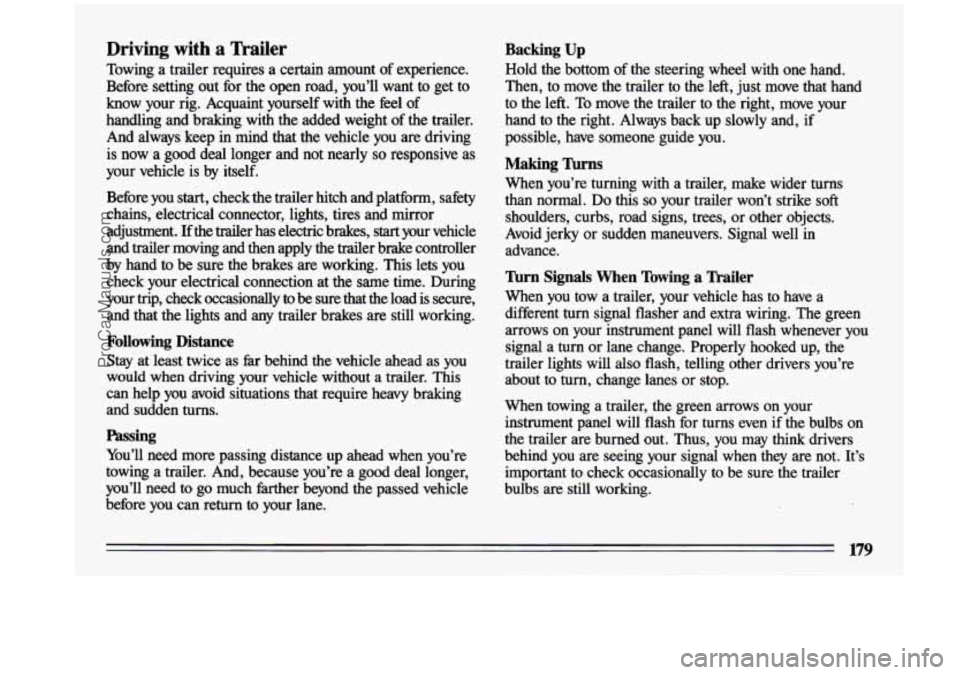
Driving with a Trailer
Towing a trailer requires a certain amount of experience.
Before setting out for the open road, you’ll want to get t\
o
know your rig. Acquaint yourself with the
feel of
handling and braking with the added weight of the trailer.
And always keep in mind that the vehicle you
are driving
is now a good deal longer and not nearly
so responsive as
your vehicle is by itself.
Before you
start, check the trailer hitch and platform, safety
chains, electrical connector, lights, tires and mirror
adjustment. If the trailer has electric brakes,
start your vehicle
and trailer moving and then apply the trailer brake controller \
by hand to be sure the brakes
are working. This lets you
check your electrical connection at the same time. During
your trip, check occasionally
to be sure that the load is secure,
and that the lights and any trailer brakes are still working.
Following Distance
Stay at least twice as fit, behind the vehicle ahead as you
would when driving your vehicle without a trailer. This
can help you avoid situations that require heavy braking
and sudden turns.
Passing
You’ll need more passing distance up ahead when you’re
towing
a trailer. And, because you’re a good deal longer,
you’ll
need to go much farther beyond the passed vehicle
before you can return to your lane.
Backing Up
Hold the bottom of the steering wheel with one hand.
Then, to move the trailer to the left, just move that hand
to the left.
To move the trailer to the right, move your
hand to the right. Always back up slowly and, if
possible, have someone guide you.
Making nrns
When you’re turning with a trailer, make wider turns
than normal.
Do this so your trailer won’t strike soft
shoulders, curbs, road signs, trees, or other objects.
Avoid jerky or sudden maneuvers. Signal well in
advance.
Turn Signals When Towing a Mler
When you tow a trailer, your vehicle has to have a
different turn signal flasher and extra wiring. The green arrows on your instrument panel will flash whenever you
signal a turn or lane change. Properly hooked up, the
trailer lights will also flash, telling other drivers you’re \
about to turn, change lanes or stop.
When towing a trailer, the green arrows on your instrument panel will flash for turns even if the bulbs on
the trailer are burned out. Thus, you may think drivers
behind you are seeing your signal when they are not. It’s
important to check occasionally to be sure the trailer
bulbs are still working.
179
ProCarManuals.com
Page 251 of 324

Windshield Wiper Blade Replacement
-1
Replacement blades come in different types and are
removed in different ways. Here’s how to remove the type
with a spring release:
1. Pull the windshield wiper arm away from the
2. Press down on the spring with a screwdriver and pull
3. Push the new wiper blade securely onto tL wiper
windshield.
the blade assembly off the wiper
arm.
arm.
Loading Your Vehicle
G INFORMATION
VEHICLE CAP. WT.
FRT. CTR.
RR. TOTAL LBS. KG
MAX. LOADING
& GVWR SAME AS VEHICLE
1 CAPACITY WEIGHT XXX COLD TIRE
TIRE SIZE SPEED PRESSURE
RTG PSI/KPa
Two labels on your vehicle show how much weight it
may properly carry. The Tire-Loading Information label
found on the rear edge of the driver’s door tells you the
proper size, speed rating and recommended inflation
pressures for the tires on your vehicle. It also gives you
important information about the number of people that
,
can be in your vehicle and the total weight that you can
carry. This weight is called the Vehicle Capacity Weight
and includes the weight
of all occupants, cargo, and all
nonfactory-installed options.
249
ProCarManuals.com